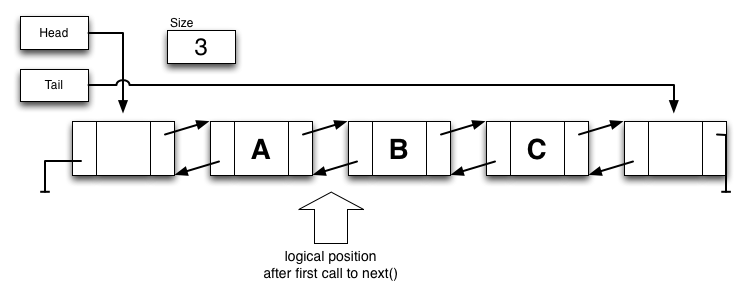Lab 5 – Link ‘em up!
Lab 5 – Link ‘em up!
- Lab 5 Home
- Warmup
- Part 1
- Part 2
- Part 3
- Submission
Part 2 – ListIterator
Once your MyLinkedList class is working, you will need to create a
ListIterator which is returned by the listIterator() method. You can
do this through the use of a helper class MyLinkedListIterator nested in the
same file as MyLinkedList, in the same way as it was implemented in the
warmup.
class MyLinkedListIterator implements ListIterator<T> {
// Instance variables here
public boolean hasNext() {
// Your code here
}
// More methods, etc.
}
The ListIterator is able to traverse the list by moving a space at a time in
either direction. It might be helpful to consider that the iterator has size+1
positions in the list: just before the head, between the 0 and 1 index, …,
just after the tail. After one call to next(), the iterator is logically in
the state shown below.

You will need to implement all of the following methods. See ListIterator for details.
Public methods for MyListIterator
public boolean hasNext()- Returns tru`e if there are more elements when going in the forward direction.
public T next()- Returns the next element in the list when going forward.
Throw a
NoSuchElementExceptionif there is no such element. public boolean hasPrevious()- Returns
trueif there are more elements when going in the reverse direction. public T previous()- Returns the next element in the list when going backwards.
Throw a
NoSuchElementExceptionif there is no such element.
Programming Hints
Since the cursor of the ListIterator exists logically between two nodes, I
found it was useful to just keep references to the next Node and the previous
Node. I also kept an int value of the index of the next node.
If you construct your MyLinkedList to use sentinel nodes as discussed in the
book and lecture, and you properly throw exceptions for going out of range,
you shouldn’t have to worry about checking for null values at the ends of
the list since the sentinel nodes are there.
You will need to keep some state information for the Iterator as well to
check if the underlying list has been modified since the iterator was created.
Modifications can leave the iterator in an undefined state. This happens, for
example, when the nodes around the current index are deleted. Therefore you
should check that the list hasn’t been modified by before you let an iterator
move to another element.
An easy way to do this is to have both the list and the iterator keep track of
the number of modifications that have been made to the list. When the iterator
is created it grabs the list’s modification count. If the iterator finds that
its modification count is different from the list’s, you will know that the
list structure has been changed and that the iterator is no longer viable. See
modCount
and the text for additional details and suggestions. Throw a
ConcurrentModificationException in these cases.
Public Methods to add to MyLinkedList
Once you are sure your iterator is working, you should override the following
methods in MyLinkedList. Each of these should just create a new
MyListIterator and return it.
public ListIterator<T> listIterator()
public Iterator<T> iterator()- These methods return a new instance of
MyListIteratorfor the current list.
Note: You inherit a working ListIterator from AbstractList, but the one
you create will be more efficient. I suggest that while you are building and
initially testing MyListIterator, you create differently named methods to
use. I tend to use names like QQQiterator() and QQQlistIterator() until
I’m sure it is working correctly. If you jump right into overriding
iterator()/listIterator() then things like toString() may stop working
for you.
Be sure to name them iterator() and listIterator() in your submitted
MyLinkedList and JUnit code. Some students in the past left it as
QQQiterator() which broke things, and made the graders think you had skipped
that step.
Testing your Iterator
You’ll want to test MyListIterator and be sure that it works properly. You
should do this by printing out the entire list forwards and backwards using
your the iterator. Start at the beginning of the list and call hasNext() and
next() using a loop until hasNext() returns false, printing out the entry at
each step. This is similar to how you computed the sum in the warmup. Then,
use hasPrevious() and previous() to return each entry until the iterator
reaches the beginning of the list.
Test that if the underlying list is modified, your iterator throws a
ConcurrentModificationException.